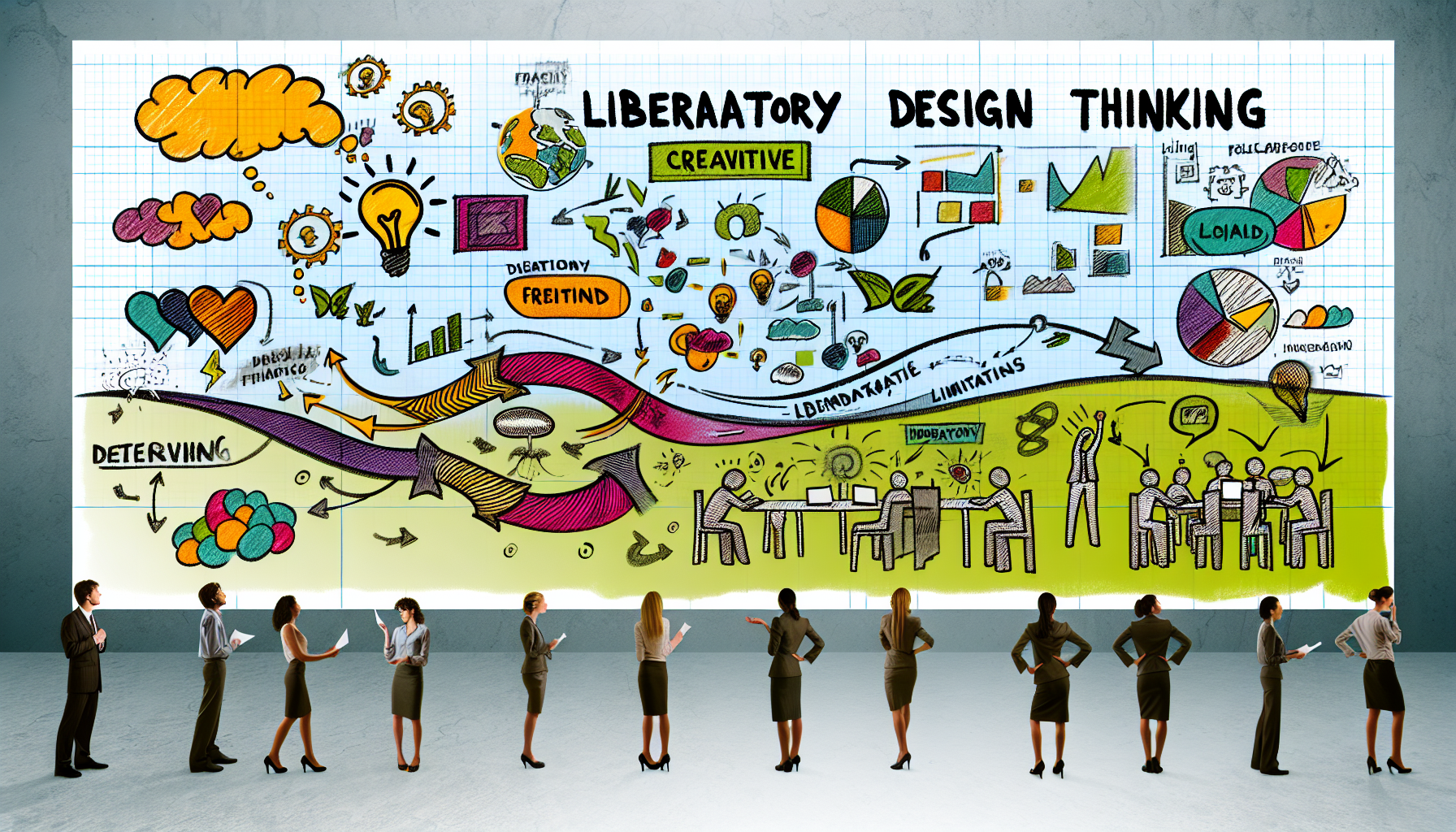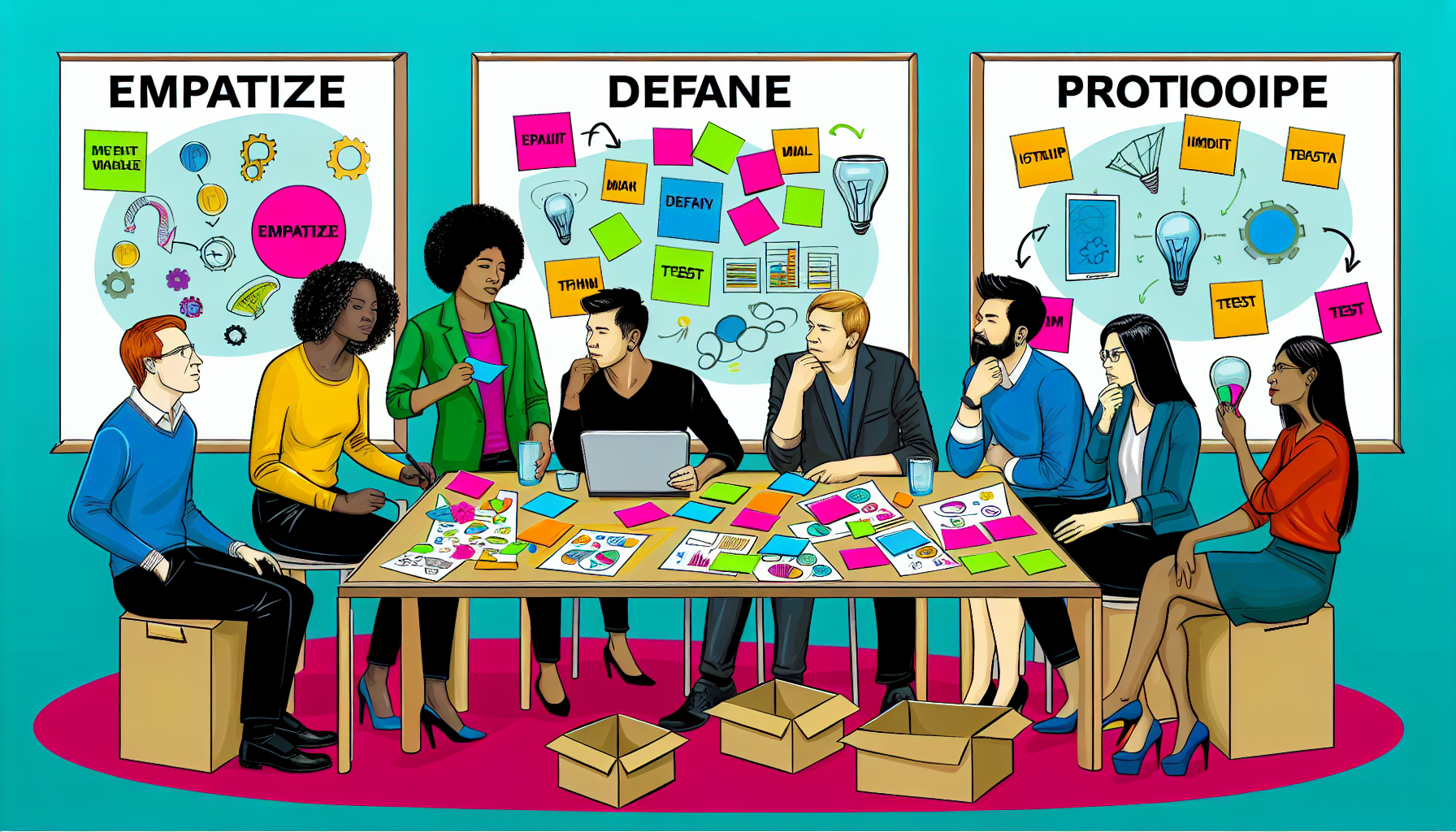Explore how Design Thinking empowers problem-solving with innovative strategies. Learn about Liberatory Design Thinking, IBM Design Thinking Badge, and its impact on customer experience.

Design thinking is a human-centered approach to problem-solving that emphasizes understanding the needs and perspectives of users. It originated from the field of design, but its applicability has expanded to various industries, including business, education, and healthcare. By integrating elements of empathy, collaboration, and experimentation, design thinking facilitates innovative solutions that prioritize user experience.
Unlike traditional problem-solving methods that often rely on linear, analytical approaches, design thinking is iterative and fluid. It encourages teams to explore multiple possibilities while looping back through the stages of ideation, prototyping, and testing. This fluidity allows for flexibility, which is beneficial in addressing complex challenges that traditional models may overlook.
The core principles of design thinking include empathy, which involves a deep understanding of users’ needs through observation and engagement. Collaboration is critical as diverse perspectives can lead to richer ideas and more comprehensive solutions. Experimentation is encouraged to foster creativity; this means failing fast and learning from those failures, ultimately leading to refined solutions that resonate with users.
Design thinking also promotes a shift in mindset from problem-focused to solution-oriented. By reframing how challenges are approached, organizations can harness the full potential of creative problem-solving to enhance customer experiences and improve strategy implementation. As industries continue to evolve, the significance of design thinking in fostering innovation cannot be overstated. It serves as a valuable framework for generating ideas that are not only effective but also resonate deeply with users, ensuring lasting impact.
The design thinking process comprises five primary stages: Empathize, Define, Ideate, Prototype, and Test. Each phase is crucial for fostering innovative solutions tailored to user needs. Understanding and effectively navigating these stages can significantly enhance collaborative efforts among team members.
The first stage, Empathize, involves gaining a deep understanding of the users and their experiences. This can be accomplished through various techniques such as interviews, surveys, and observations. By immersing themselves in the users’ environment, teams can identify pain points and uncover insights that may not be immediately obvious. Actionable tips for conducting effective user research include asking open-ended questions and encouraging participants to share their stories and feelings.
After gathering insights, the next stage is Define. In this phase, teams synthesize their findings to develop a clear problem statement. A well-defined problem statement guides the innovation process and focuses efforts on addressing specific user needs. It is beneficial to frame the problem in a way that highlights the user’s perspective, ensuring that proposed solutions are relevant and user-centered.
The Ideate stage encourages brainstorming to generate a wide range of ideas and solutions. This is a creative process where no idea is too outlandish. Teams should aim for quantity over quality initially, as this fosters an open environment for creative thinking. Techniques such as mind-mapping or the use of the SCAMPER method can stimulate innovative thought, leading to potential solutions that may not have emerged through traditional approaches.
Following ideation, the Prototype stage entails creating low-fidelity representations of the ideas generated in the previous phase. Prototypes can take many forms, including sketches, storyboards, or simple models. These prototypes serve as tools for visualizing ideas and gathering feedback. Finally, the Test stage involves presenting prototypes to users for feedback. This iterative process allows teams to refine their solutions based on real user insights, ultimately leading to a more effective and user-centered final product.

Liberatory design thinking represents an evolution of the traditional design thinking framework, emphasizing inclusivity and social impact in the problem-solving process. This approach recognizes that many systemic issues stem from historical inequalities and aims to address these challenges by incorporating diverse perspectives. By centering marginalized voices, liberatory design thinking challenges the status quo, ultimately leading to innovative and equitable solutions. It involves engaging communities in the design process and leveraging their lived experiences to create frameworks that are not only effective but also resonate culturally and contextually.
One key aspect of liberatory design thinking is its commitment to co-creation with stakeholders. This method entails actively involving community members in every phase of the design process, from problem identification to solution implementation. Case studies illustrate this approach’s successes across various sectors. For example, in the area of urban planning, collaborative workshops among residents, city planners, and local organizations led to the development of public spaces that reflect community needs and priorities. Such projects often yield lasting, positive changes within communities, enhancing social cohesion and wellbeing.
Additionally, liberatory design thinking encourages the creation of solutions that tackle underlying systemic issues. By employing tools like empathy mapping and participatory design methods, practitioners can uncover hidden barriers experienced by marginalized populations. These insights can lead to more comprehensive solutions, addressing not just symptoms but root causes of challenges. Communities equipped with liberatory design thinking strategies can advocate for policy changes and resource allocation that further empower them, fostering an environment of equity and justice.
This inclusive framework has significant implications for various fields such as education, health care, and environmental sustainability. By embracing diverse perspectives and actively challenging injustices within the design process, liberatory design thinking has the potential to transform the way organizations operate and serve their communities.
Design thinking plays a pivotal role in elevating customer experience by providing a structured framework for understanding and addressing customer needs, emotions, and behaviors. This human-centered approach is particularly valuable in today’s marketplace, where customer expectations are continually shifting. By prioritizing empathy and collaboration, design thinking enables organizations to create products and services that resonate deeply with their target audiences.
One effective strategy within design thinking is customer journey mapping, which involves visualizing the customer’s interactions with a company across different touchpoints. This process uncovers pain points, moments of delight, and critical feedback that inform product development and service enhancements. By actively involving customers in co-design sessions, businesses can gain rich insights that lead to innovative solutions tailored to their audience’s needs. This method not only improves functionality but also fosters a sense of ownership among customers.
Another crucial element of design thinking is the implementation of feedback loops. Creating systems for regularly collecting and analyzing customer feedback allows businesses to remain agile and responsive to evolving preferences. This iterative testing and feedback process empowers organizations to make data-driven decisions, ultimately leading to products and services that exceed expectations. Such responsiveness can significantly increase customer loyalty and advocacy, as customers feel their voices are heard and valued.
Lastly, enhancing user engagement through tailored experiences is essential for improving customer satisfaction. Employing design thinking principles encourages teams to think creatively about how to captivate users at each stage of their journey. By leveraging design thinking techniques, organizations can craft memorable experiences that not only align with customer expectations but also differentiate themselves from competitors.
Enhancing your skills and knowledge in design thinking is crucial for navigating the complexities of problem-solving in various contexts. One effective way to begin this journey is by enrolling in online courses that provide structured learning and practical experience.
A notable program is the IBM Design Thinking Badge, which offers a comprehensive overview of design thinking principles and practices. This course not only aids in grasping the foundational elements but also allows individuals to earn a credential that demonstrates their expertise to potential employers.
In addition to online courses, engaging with relevant literature can significantly bolster your understanding of design thinking. Numerous books delve deeply into the methodologies, theories, and applications of design thinking in different fields. Titles such as “Change by Design” by Tim Brown and “The Design of Business” by Roger Martin can provide valuable insights and case studies, enabling learners to grasp how design thinking has been successfully implemented in real-world scenarios.
Participating in workshops and conferences is another excellent strategy for skill enhancement. These events often feature industry experts who share their knowledge and experiences, providing attendees with practical tools and new perspectives. Workshops also offer opportunities for hands-on practice, which is essential for internalizing the concepts discussed in theory. Furthermore, networking with other participants can lead to collaborative opportunities and peer support essential for growth in this discipline.
Staying current in the evolving field of design thinking requires continuous learning and adaptation. Following design thinking experts on social media and subscribing to relevant blogs or podcasts can keep you informed about emerging trends and innovative strategies. By integrating these methods into your professional development, you can cultivate your expertise in design thinking and effectively contribute to problem-solving initiatives across various industries.
Design thinking has emerged as a powerful problem-solving approach that transcends various industries, allowing organizations to tackle complex challenges with creativity and collaboration. Throughout this section, we will examine real-world case studies from innovative companies and organizations that have effectively utilized design thinking methodologies to generate impactful solutions.
One notable example is Airbnb, which faced significant challenges in user experience and customer retention. By employing design thinking, the company conducted extensive user research to gain insights into customer needs and pain points. They utilized empathy mapping and prototyping techniques to redesign their platform, emphasizing seamless navigation and personalized experiences. The outcome was a remarkable increase in customer satisfaction and a boost in bookings, illustrating the efficacy of design thinking in enhancing user engagement.
Another powerful case is IBM’s reinvention of its services through design thinking. IBM faced difficulties in maintaining competitiveness in the rapidly evolving tech landscape. By integrating design thinking into its organizational culture, IBM emphasized collaboration across teams and departments. They hosted workshops and brainstorming sessions to cultivate ideas that address client challenges. This led to the development of user-centric software solutions that significantly improved client satisfaction ratings and fostered long-term client relationships.
In the healthcare sector, the Cleveland Clinic employed design thinking to improve patient experiences and streamline operations. Faced with the complexities of patient management and care coordination, the Cleveland Clinic began a design thinking initiative that involved cross-disciplinary teams. They utilized field observations and prototyping to identify gaps in service delivery. As a result, the clinic implemented a new patient navigation system that reduced wait times and improved overall patient outcomes, showcasing the transformative potential of design thinking in healthcare.
These case studies exemplify how design thinking can drive innovation and problem-solving across diverse sectors. By focusing on empathy, collaboration, and experimentation, organizations can harness creative strategies to address their most pressing challenges effectively.

Design thinking has gained substantial traction in various industries, with numerous firms emerging as leaders in this innovative approach. Here, we present a selection of notable design thinking firms that have made remarkable contributions, showcasing their unique methodologies and the impact they have achieved through creative strategies.
First on the list is IDEO, a pioneer in the design thinking movement, known for its human-centered approach to innovation. IDEO has partnered with an array of organizations, from startups to Fortune 500 companies, helping them cultivate creative solutions that enhance user experiences. Their emphasis on empathy allows clients to understand the needs of their target audiences, which is a fundamental principle of design thinking.
Another significant player is frog design, an international design and strategy firm that integrates design thinking into the fabric of product development and branding. Frog collaborates across disciplines to combine technology with creativity, promoting innovation in areas such as healthcare, mobility, and consumer products. Their iterative design processes exemplify the core concepts of design thinking, generating thoughtful and effective outcomes for their clients.
Continuing with this trend is the firm Continuum, renowned for its ability to merge design with business strategy. They focus on creating impactful experiences by leveraging design thinking to drive social change and improve business performance. Their diverse team draws insights from various fields, resulting in comprehensive approaches that address complex problems.
Lastly, the consultancy firm IDEO.org specializes in using design thinking to improve social sector initiatives. By applying human-centered design to nonprofit challenges, they deliver impactful solutions that drive measurable change in communities globally. Their work emphasizes the importance of empathy and user involvement, critical elements in the design thinking process.
These firms stand as exemplary models of how design thinking can be utilized to generate innovative solutions across different contexts. Their commitment to integrating creativity and strategy makes them influential entities in the design thinking landscape, offering inspiration and collaboration opportunities for those looking to enhance their problem-solving capabilities.

To effectively integrate design thinking into your organization, it is essential to cultivate a culture that promotes creativity. Begin by encouraging an environment where team members feel safe to share innovative ideas without fear of criticism. This can be achieved through regular brainstorming sessions, where all input is valued and considered. Emphasizing psychological safety promotes open communication and fosters an atmosphere conducive to exploration and experimentation.
Building diverse teams is another crucial aspect of successful design thinking implementation. By bringing together individuals from varied backgrounds, disciplines, and perspectives, organizations can enhance their creative potential. Diversity leads to a wider range of insights and innovative solutions, as team members collectively contribute distinct viewpoints that challenge conventional thinking. It is important to actively seek out individuals with different skills and experiences during team formation to leverage this diversity effectively.
Facilitating structured workshops is also an effective strategy for promoting design thinking practices. These workshops can serve as a platform for collaborative problem-solving activities that allow participants to apply design thinking methodologies, such as empathy mapping and prototyping. By creating scenarios that require team members to tackle real-world challenges, these workshops can spark creativity and provide hands-on experience with design thinking techniques. Consider inviting external facilitators specializing in design thinking to guide sessions and introduce fresh perspectives.
Continuous user feedback is integral to the design thinking process. It is vital to engage users throughout various stages of development, ensuring that their needs and preferences are at the forefront of design decisions. Employ techniques such as user testing, surveys, and interviews to gather valuable insights that can inform enhancements and iterations. By embedding feedback loops into your workflow, you will ensure that the final product aligns with user expectations and ultimately achieves greater success in the market.
Evaluating the effectiveness of design thinking initiatives is paramount for organizations aiming to refine their creative strategies and achieve impactful problem-solving outcomes. To measure success, a blend of qualitative feedback and quantitative metrics can provide comprehensive insights. Qualitative feedback may include interviews, surveys, and focus groups, allowing stakeholders to share subjective experiences and perceptions surrounding design initiatives. This type of feedback can unveil user satisfaction levels, pinpoint areas requiring improvement, and illustrate how the design thinking process has influenced innovation.
On the other hand, quantitative metrics deliver measurable data that helps in assessing the effectiveness of design thinking practices. Key performance indicators (KPIs), such as project completion rates, time-to-market, and return on investment (ROI), serve as concrete tools for tracking success. By analyzing data collected from these metrics, organizations can identify patterns and critical success factors, enabling them to make informed decisions regarding future design thinking projects.
Furthermore, the iterative nature of design thinking allows organizations to evolve based on the results gathered. Conducting regular assessments not only measures the success of individual projects but also contributes to a culture of continuous improvement within the organization. This ongoing evaluation process encourages teams to iterate on their solutions, ensuring that they adapt to changing user needs and market conditions, ultimately driving sustainable innovation.
Measuring the success of design thinking initiatives through a combination of qualitative and quantitative methods is essential. Such evaluations not only help organizations understand the impact of their creative strategies but also foster an environment where iterative improvements can thrive, promoting a long-term commitment to innovation and effective problem-solving.
Find Scholarships Offered by Countries Worldwide for Your Academic Goals.
Chose where you want to study, and we will let you know with more updates.